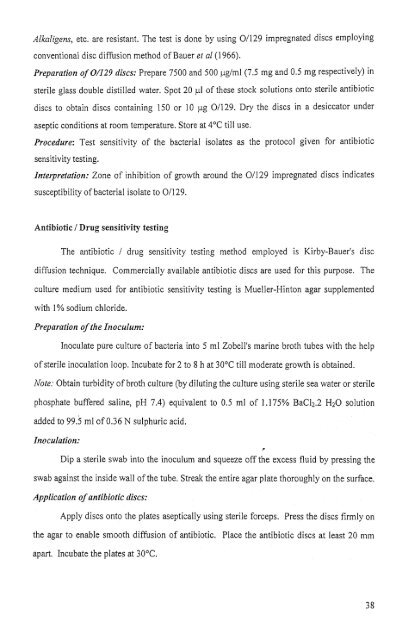, Diagnosis an-&& of Shrimp Diseases - Central Institute of ...
, Diagnosis an-&& of Shrimp Diseases - Central Institute of ...
, Diagnosis an-&& of Shrimp Diseases - Central Institute of ...
- No tags were found...
You also want an ePaper? Increase the reach of your titles
YUMPU automatically turns print PDFs into web optimized ePapers that Google loves.
Alkaligens: etc. are resist<strong>an</strong>t. The test is done by using 0/129 impregnated discs e~nployingconventional disc diff~ision method <strong>of</strong> Bauer et a1 (1966).Prepnrtrtion <strong>of</strong> 01'129 discs: Prepare 7500 <strong>an</strong>d 500 pgIm1 (7.5 rng <strong>an</strong>d 0.5 mg respectively) insrerile glass double distilled water. Spot 20 p1 <strong>of</strong> these stock solutions onto sterile <strong>an</strong>tibioticdiscs to obtain discs containing 150 or 10 pg 01129. Dry the discs in a desiccator underaseptic conditions at room temperature. Store at 4OC till use.Procedure: Test sensitivity <strong>of</strong> the bacterial isolates as the protocol given for <strong>an</strong>tibioticsensitivity testing.Interpretation: Zone <strong>of</strong> inhibition <strong>of</strong> growth around the 01129 impregnated discs indicatessusceptibility <strong>of</strong> bacterial isolate to 01129.Antibiotic / Drug sensitivity testingThe <strong>an</strong>tibiotic I drug sensitivity testing method employed is Kirby-Bauer's discdiffusion technique. Co~nmercially available <strong>an</strong>tibiotic discs are used for this purpose. Theculture medium used for <strong>an</strong>tibiotic sensitivity testing is Mueller-Hinton agar supplementedwith 1 % sodium chloride.Preparation <strong>of</strong> the Irloculum:Inoculate pure culture <strong>of</strong> bacteria into 5 ml Zobell's marine broth tubes with the help<strong>of</strong> sterile inoculation loop. Incubate for 2 to 8 h at 30°C till moderate growth is obtained.Note: Obtain turbidity <strong>of</strong> broth culture (by diluting the culture using sterile sea water or sterilephosphate buffered saline, pH 7.4) equivalent to 0.5 ml <strong>of</strong> 1.175% BaC12.2 Hz0 solutionadded to 99.5 ml <strong>of</strong> 0.36 N sulphuric acid.Inoculation:9Dip a sterile swab into the inoculum <strong>an</strong>d squeeze <strong>of</strong>f the excess fluid by pressing theswab against the inside wall <strong>of</strong> the tube. Streak the entire agar plate thoroughly on the surface.Application <strong>of</strong> <strong>an</strong>tibiotic discs:Apply discs onto the plates aseptically using sterile forceps. Press the discs firmly onthe agar to enable smooth diffusion <strong>of</strong> <strong>an</strong>tibiotic. Place the <strong>an</strong>tibiotic discs at least 20 mmapart. Incubate the plates at 30°C.
















